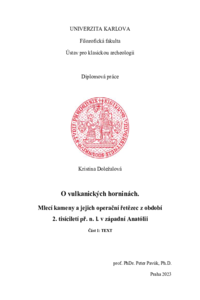The tale of volcanic rocks. Assessing the grinding stones and their chaîne opératoire in 2nd millennium Western Anatolia
O vulkanických horninách. Mlecí kameny a jejich operační řetězec z období 2. tisíciletí v západní Anatólii
diplomová práce (OBHÁJENO)

Zobrazit/
Trvalý odkaz
http://hdl.handle.net/20.500.11956/184437Identifikátory
SIS: 249717
Kolekce
- Kvalifikační práce [24991]
Autor
Vedoucí práce
Oponent práce
Roosevelt, Christopher
Schwall, Christoph
Fakulta / součást
Filozofická fakulta
Obor
Klasická archeologie
Katedra / ústav / klinika
Ústav pro klasickou archeologii
Datum obhajoby
4. 9. 2023
Nakladatel
Univerzita Karlova, Filozofická fakultaJazyk
Angličtina
Známka
Výborně
Klíčová slova (česky)
mlecí kameny|Kaymakçı|surovina|doba bronzová|traseologická analýzaKlíčová slova (anglicky)
grinding stones|Kaymakçı|raw material|Bronze Age|use-wear analysisPředkládaná práce se zaměřuje na soubor mlecích kamenů z Kaymakçı, turecké opevněné výšinné lokality pozdní doby bronzové, snaží se zrekonstruovat jejich operační řetězec a zasadit nové informace do kontextu poznání západní Anatólie v 2. tisíciletí př. n. l. Základní zpracování artefaktů zahrnovalo morfotypologickou, geologickou, traseologickou a prostorovou studii souboru v rámci tohoto sídliště. Jednotlivé zjištěné aspekty operačního řetězce mlecích kamenů z Kaymakçı byly následně porovnány s dvěma publikovanými soubory stejného typu artefaktů ze západní Anatólie (Afrodisias a Trója), aby byly zjištěny jeho opakující se vzorce pro dobu bronzovou. Soubor mlecích kamenů z Kaymakçı odhalil, že tyto artefakty hrály důležitou roli v běžném životě i nadregionálních stycích a obchodu. Na sídlišti byly doloženy především aktivity spojené s jejich používáním, reutilizací a skartací, oproti tomu těžba suroviny a samotná výroba artefaktů zde doposud nebyly zdokumentovány. Vzhledem k provenienční analýze je zřejmé, že obyvatelé byli ochotni investovat mnoho času a energie na jejich transport ze značné vzdálenosti. Dá se také předpokládat určitá míra specializace produkce, která je nepřímo doložená standardizací tvarů horních mlecích kamenů. Tyto nástroje byly taktéž zručně tvarovány do ergonomických forem...
The thesis examines grinding stones from the Anatolian Bronze Age site of Kaymakçı. It aims to reconstruct their chaîne opératoire and to place the new findings in the frame of Western Anatolia in the 2nd Millennium BC. The general processing of the assemblage included morphological, geological, use-wear and spatial study of the assemblage in the context of the settlement. The various aspects of the grinding stones chaîne opératoire identified at Kaymakçı were then compared with two published grinding stone assemblages from Western Anatolia (Aphrodisias and Troy) to identify their repeating patterns for the Bronze Age. The grinding stone assemblage from Kaymakçı revealed that these artifacts played an important role in everyday life, as well as in trans-regional contacts and trade. While activities related to their use, reuse and disposal have been well attested, raw material extraction and production were not documented so far. As shown by the provenance analysis, people were willing to invest a lot of time and energy to transport them. A certain degree of specialization of production can also be assumed, which is indirectly evidenced by the standardization of the upper grinding stone shapes. These tools were skillfully shaped and enhanced with ergonomic adjustments suitable for comfortable...
